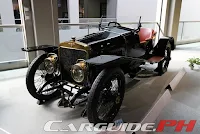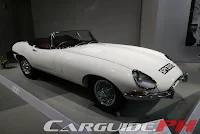 |
| Photos by Ulysses Ang |
The excitement from the children and the seniors were palpable. When the doors of the museum were opened, the children immediately rushed to line up behind their teacher while the seniors excitedly moved in, as quickly as their legs can take them. We, young/old adults, “calmly” took our time entering.
With a total floor area of around 19,000 square meters, there was more than enough room for everyone. Right center at the main entrance, greeting every museum-goer, was the Toyoda Model AA in all its glory. This is the first of the many iconic cars housed in the Toyota Automobile Museum. The museum is committed to exploring the history of the automobile and it includes a world-class collection of 140 vehicles of historical importance from around the world.
In the European and American car section, it was easy to be captivated by the displays. We found some children furtively taking down notes in front of the Ford Model T (1909), while some girls were busy admiring the Benz Patent Motorwagen (1886). A couple of boys seemed mesmerized by the engine parts of the Bugatti Type 35B (1926). The brightly colored yellow hats can be seen huddling by legendary vehicles such as the Panhard Levassor B2 (1901), Rolls-Royce 40/50HP Silver Ghost (1910), De Sort Airflow Series SE (1934), Alfa Romeo 6C 1750 Gran Sport (1930), Delage Type D8-120 (1939), Packard Twelve (1939), Mercedes Benz 300SL (1955), and the pink Cadillac.
Off to the Japanese cars exhibit, this time we saw the seniors gathering around the Toyopet Crown Model RS (1955). They were excitedly chattering and pointing at the car and we can only surmise that this model must bring back a lot of memories for them. It was heartwarming to see one senior who was “driving” his automated wheelchair, zooming in on a couple of models: the Subaru 360 Model K111 (1958), the Datsun Model 112 (1956), Toyota 2000GT Model MF10 (1968), and Honda S500 Model AS280 (1964). As the seniors fawned and took pictures of the cars, their enthusiasm was infectious. They seemed like kids again, seeing a favorite toy. Their bright expressions and sparkling eyes mirrored that of the children we saw a while ago.
After a few hours and having to use the extra memory cards, we moved on to the sections in the Annex Building. Most of the children were camped out at the Tiny Studio area, playing with toys and interactive games. We literally were walking through time in the six exhibit zones that showed the history of Japanese life and culture, together with the progress of motorization in Japan. From the early westernization to the economic boom, each section catalogued the lifestyle of the era with approximately 2000 items. There were rickshaws, coca cola bottles, post-war trucks, and even pictures of Elvis Presley. As we were taking in the 1960s exhibit, a group of young girls seemed transfixed at the old Barbie dolls on display while some seniors just breezed through the era as if thinking, “Been there, done that.”
People say that the world fell in love with the automobile in the 20th century. And that love story is still going strong. It is a love story that knows no bounds or age. And the Toyota Automobile Museum is there to “document” it – for the old ones to reminisce, for the young/old adults to explore, and for the young ones to inspire.
Museum Information
- Hours: 9:30 am-5:00 pm (0900-1700)
- Closed: Monday
- Admission Fee: Adults 1,000 yen
- How to get there: From Nagoya Station, take the Higashiyama Subway Line to Fujigaoka and transfer to the Tobu Kyuryo Line (Linimo). The museum is a few steps, around 10-minute walk, from Geidaidori Station (Toyota Hakubutsukan-mae). The trip from Nagoya Station takes about 45 minutes and costs 580 yen one way.










































































so who's the car design copycat now?
ReplyDeleteAwesome that the museum to include non-Toyota automobiles.
ReplyDeleteThey seemed like kids again, seeing a favorite toy. Their bright expressions and sparkling eyes mirrored that of the children we saw a while ago.best electric fuel pump
ReplyDelete